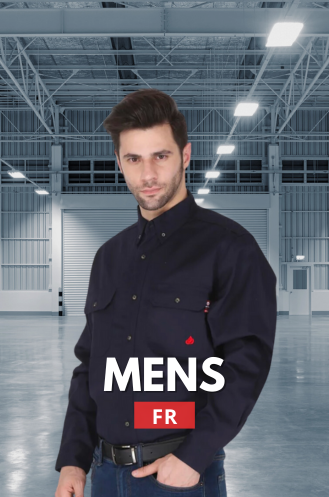Safety is something we often ignore until something goes wrong. And to be frank, choosing the right Fire Retardant Clothing isn’t just about wearing a uniform. It’s about protecting yourself, staying comfortable, and making sure your clothing actually does its job when things get risky.
I remember my first industrial job. Everyone was talking about helmets, gloves, and safety boots-but I didn’t pay much attention to my clothes. One day, a colleague’s sleeve caught a spark. Luckily, he was wearing proper Fire Retardant Clothing, and it saved him from injury. That day stuck with me. From then on, I realized how important it is to pick the right fire-resistant clothing.
So, if you’re wondering how to choose the right Fire Retardant Clothing for your job, here’s a casual, easy-to-understand guide.
Why Fire Retardant Clothing Matters
Let’s be honest-your clothing can literally be your first line of defense against burns and injuries. Fire Retardant Clothing is made to resist ignition, slow down flames, and give you extra seconds to react in dangerous situations.
-
Protects from sparks or sudden flames
-
Reduces the risk of severe burns
-
Makes you feel safer and more confident at work
-
Often required by workplace safety regulations
To be frank, skipping proper fire-resistant clothing is just not worth the risk. Your safety comes first.
Step 1: Understand Your Job Risks
Different jobs have different fire hazards. Knowing your workplace risks is step one.
-
Industrial work: Sparks, welding, molten metal
-
Electrical jobs: Arc flashes, short circuits
-
Oil & gas industry: Flammable liquids, high heat surfaces
-
Firefighting: Direct flame exposure and extreme heat
Jokes apart, knowing your risk helps you pick clothing with the right protection. Not every job needs the same thickness or material.
Step 2: Check the Material
The material of your Fire Retardant Clothing is very important. Some fabrics are naturally flame-resistant; others are chemically treated.
-
Nomex: Lightweight, flame-resistant, good for industrial and firefighting jobs
-
Kevlar blends: Strong, durable, abrasion-resistant
-
Treated cotton: Comfortable, flame-resistant, often used for light industrial work
-
Proban-treated fabrics: Used for labs or chemical handling
Be kind to yourself and pick something breathable if you’re working long hours. Overheating can be a real problem.
Step 3: Look for Certifications
Let’s be honest, labels matter. Proper certifications prove the clothing meets safety standards.
-
NFPA 2112: Flame-resistant garments in industrial settings
-
NFPA 70E: Electrical safety and arc flash protection
-
ISO 11612: International standard for heat and flame protection
Always check the tag. Don’t just trust the brand. Certifications are what really count.
Step 4: Fit and Comfort
Comfort is often ignored, but it’s crucial. Ill-fitting Fire Retardant Clothing can restrict movement or create hazards.
-
Make sure it allows easy movement
-
Sleeves and collars shouldn’t be too tight
-
Lightweight fabrics for long shifts
-
Good ventilation to avoid overheating
To be frank, even the best material won’t help if you’re constantly tugging or adjusting your clothing.
Step 5: Layering and Accessories
Sometimes, one layer isn’t enough. Depending on your job, layering can add extra protection.
-
Long-sleeve shirts under jackets
-
Pants with reinforced knees
-
Gloves, boots, and helmets made from flame-resistant materials
-
Avoid synthetic fabrics underneath-they can melt
Jokes apart, proper layering can save you in dangerous situations.
Step 6: Maintenance and Care
Even the best Fire Retardant Clothing loses effectiveness if not cared for properly.
-
Wash according to instructions
-
Avoid bleach or fabric softeners-they reduce flame resistance
-
Inspect regularly for tears or damage
-
Replace clothing if worn out or damaged
Be kind to your clothing-it’s literally protecting your life.
For more details, you can also check our complete guide available on Forge FR Online.
Stay connected with us on Instagram for the latest updates and tips
Final Thoughts
Choosing the right Fire Retardant Clothing isn’t just about buying a uniform. It’s about knowing your risks, picking the right material, ensuring comfort, and maintaining it properly.
To be frank, investing in good fire-resistant clothing is investing in your safety. Modern options are comfortable, certified, and suitable for long shifts. So take your time, know your needs, and pick wisely. Your life is worth it.
FAQs About Fire Retardant Clothing
1. Can I wear Fire Retardant Clothing casually?
Let’s be honest, you can, but it’s made for work hazards. Casual use is fine for style, but protection is the main goal.
2. How often should I replace it?
To be frank, check every 6–12 months depending on usage. Damaged clothing must be replaced immediately.
3. Is it hot to wear?
Some fabrics feel warm, but modern blends are breathable. Pick lightweight options for long shifts.
4. Can I iron or dry-clean it?
Jokes apart, follow the label. Most can be machine washed; high-heat ironing can reduce protection.
5. Does it protect against chemicals too?
Not all garments. Some are dual-purpose, but check the tag-some resist heat only, not chemicals.



